THE HOLLYWOOD REPORTER STARGATE SG-1 100th EPISODE SALUTE
On the occasion of Stargate SG-1's 100th episode, The Hollywood Reporter included a special 18-page salute to the series in its regular issue.
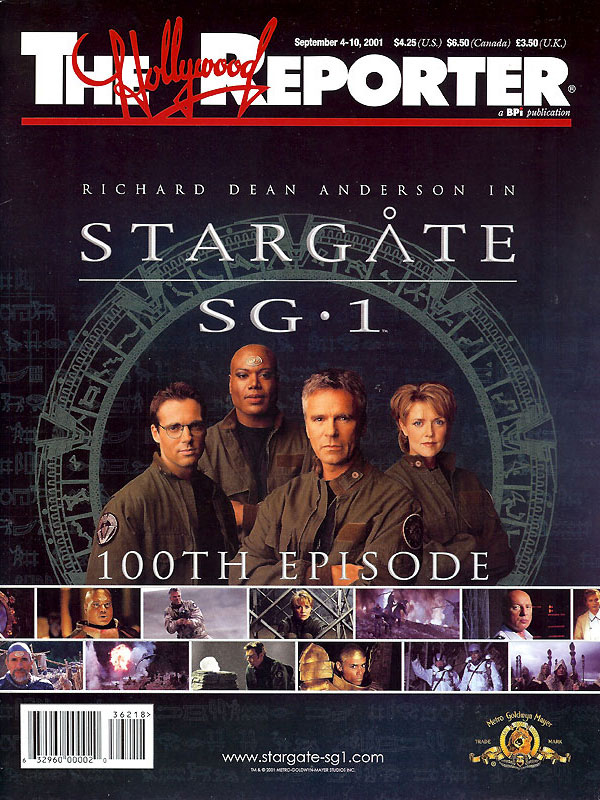
GATE EXPECTATIONS
How did an MGM sleeper become a hit syndicated series and then travel into 100th-episode infinity and beyond?
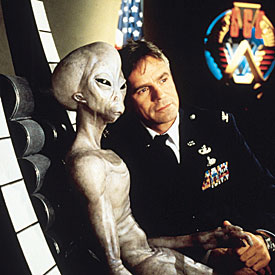
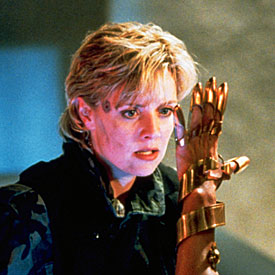
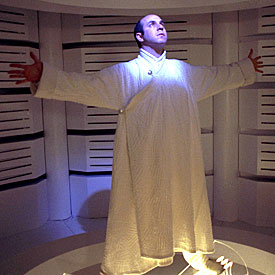
When the MGM film "Stargate" grossed $71 million in 1994, it was enthusiastically hailed as a sleeper hit. The same can now be said of the TV series. The MGM-produced program "Stargate SG-1" has attracted a loyal fan base since its Showtime debut in 1997. Now notching its 100th episode, the show is segueing to a new home on USA Networks' Sci-Fi Channel, where it will launch its sixth season in more than 70 million homes beginning June 2002.
"We've always regarded 'Stargate SG-1' as something that should be on Sci-Fi," says Bonnie Hammer, president of Sci-Fi Channel. "It has a very strong following; it's well-produced; and it's something that we believe is the right product for us."
The series revolves around a present-day U.S. Air Force team composed of a special-operations colonel, an anthropologist, an astrophysicist and an alien warrior. The crew's missions take them through an ancient gate to new worlds where they encounter unearthly and oftentimes treacherous cultures. Known as SG-1, the elite team works under the auspices of a division of Air Force Intelligence that is highly classified - only the president and the Joint Chiefs of Staff know of its existence.
Genesis
MGM Worldwide Television Group was well aware of the crew's existence when it considered bringing the highly intelligent, space-traveling team into viewers' homes in 1994. Hank Cohen, president of TV entertainment for MGM, recalls how he and his predecessor, John Symes, "could easily see what a great series this would make: an elite team of adventurers traveling through the gate to all of these other worlds."
The series sprang from a strong science-fiction foundation. MGM Television's existing $150 million, three-series deal with Showtime had already produced the sci-fi duos "Poltergeist: The Legacy Continues" and "The Outer Limits." "Stargate SG-1" became the third original series in that deal, although at the time, no one suspected the kind of impact the series would have on the young network.
"'Stargate SG-1' was our first continuous character series that worked," recalls Jerry Offsay, president of programming for Showtime Networks. "For three years - until 'Queer As Folk' and 'Soul Food' - ['Stargate SG-1'] was the only original show that was a success. 'Stargate' proved that we could do serialized drama and that was very important for us. It helped convince us that we could do shows with continuous characters. We had a great run with that show."
The timing was fortuitous since Showtime was interested in building its science-fiction block, recalls Pancho Mansfield, senior vp of development, original programming for Showtime.
As it happened, writer-producers Brad Wright and Jonathan Glassner had independently approached the studio about writing a "Stargate" TV pilot. "We both knew it was in their library, and we knew MGM was considering it as a series," recalls Wright, who, with Glassner, now serves as executive producer of "Stargate SG-1." As sophomores, Wright and Glassner previously worked together on the production staff for "The Outer Limits" in the mid-'90s.
Although Showtime had confidence in the series, Mansfield admits that spawning a show from a feature was risky. "There's always a danger with built-in preconceptions when you're coming off a film. But the name brand certainly brought people in right from the beginning who were interested in watching the show," he says.
In order to make the concept TV-ready, Wright and Glassner made some adjustments to the original story: "We needed more than one enemy, so we decided that Ra was one of many of his kind who took people from ancient Earth and put them in slavery at various points of human history. That way the galaxy is populated with the peoples of ancient Earth, and we've created new aliens and new allies," Wright explains.
Star Search
With the one-two punch of producers Wright and Glassner fleshing out the series, Symes set his sights on finding the right actor for the role of Colonel Jonathan "Jack" O'Neill, portrayed by Kurt Russell in the film. Symes approached Richard Dean Anderson ("MacGyver") and his production partner, Michael Greenburg, about signing on. Anderson not only signed on to star in the series - recently upping his contract for a sixth season - he also received an executive producer credit.
For Anderson, who was coming off the short-lived UPN series "Legend," "Stargate SG-1" had just the right mix of elements. "The movie kicked off such a strong premise, [with the gate as] an obvious visual prop that you can use week to week and also simultaneously use as a vehicle for the team to travel to different parts of the universe," Anderson explains. "I'd never done a science-fiction oriented show, and I have a mantra that I'll try anything once."
Finding the right cast for the rest of the "SG-1" team was no easy task. Ultimately, after months of searching, "it became obvious (that) Don Davis, whom Rick (Richard Dean Anderson) and I had worked with on 'MacGyver,' was a perfect General Hammond," recalls Greenburg. "He wasn't just a strict, staunch general; he had a vulnerability about him. Meanwhile, Major Samantha Carter, Amanda Tapping's character, had to be centered and comfortable as a Ph.D. who speaks from the point of view of an astrophysicist. Michael Shanks had the James Spader-Daniel Jackson anthropologist-humanitarian thing down (from the film). He was so believable that he just shined in that role. And Christopher Judge was just so formidable in his aura and his presence. He has charisma just by standing there, and that's what we were looking for in the Jaffa warrior Teal'c," concludes Greenburg.
In addition to the cast and story lines, the series' Emmy-nominated craftspeople created a package that proved a ratings asset to Showtime from the start. According to the network, when "Stargate SG-1" came on in 1997, it did extremely well as a pilot: Its two-hour premiere on a Sunday evening was Showtime's highest-rated original event that year, and the series has since remained consistent. The primary audience for "Stargate SG-1" - a whopping 60% of its viewers - are adults aged 19 to 49, evenly split between males and females, which is unusual for a sci-fi show.
"Younger people have really taken to 'SG-1,'" Cohen says. "[There are] few shows that I've been involved with in my career where I have seen the loyal outpouring of expression and devotion to a show that ['Stargate'] enjoys."
Glassner attributes the show's success to the diversity and real-world humanity of the "SG-1" crew. "One of the things that makes 'Stargate' unique and different from shows like 'Star Trek' is that it's set today, and the people are us. They're not the perfect people of the 'Star Trek' world. As a result, we can go to a planet and screw up, and get in the way and mess things up. We also have something to learn from them rather than always being the ones who have to teach something," Glassner explains.
International Flair
Apparently, action-packed humanism plays well in other countries, too. "['Stargate'] does extremely well in the syndication market and is frequently ranked No.1 [among] the action-adventure, first-run syndication [shows]," Cohen notes. "It speaks to a universal theme. For two years running, it was the only U.S. import to play during primetime in Europe," Cohen says. The show airs in 64 countries.
It wasn't until the end of the first season that Wright felt the series really found its footing. Now in its fifth season, the show's story lines have been building toward the resolution of outstanding plot threads, while they propel the action forward. "The challenge for 'Stargate SG-1' has been in making sure that the characters stay alive not only for our actors but for us, the writers," maintains Wright, noting that the franchise has a lot of life left. "You want your characters to evolve and to grow, but at the same time, you don't want them to stop being the characters that the audience started tuning in to watch in the first place."
"Previous attempts at turning a feature into a television show, for the most part, haven't been all that successful, and this has been successful beyond what we had even hoped for," says Cohen. "And I think it's because we had such a strong creative team in place, and we put a terrific star and cast in place - that's a winning formula."
According to Wright, there are plans to parlay that winning formula into a new feature film as well as a TV spin-off of the franchise.
____________________
Perenson, Melissa J., "Gate Expectations." The Hollywood Reporter. September 4-10, 2001: p. S-1+.
GATE MATES
SG-1 castmates know a thing or two about intergalactic stardom.
RICHARD DEAN ANDERSON plays Colonel Jonathan "Jack" O'Neill, whose mission is to defend Earth and explore new worlds.
The Hollywood Reporter: How does your portrayal of Colonel O'Neill differ from the character in the movie?
Richard Dean Anderson: I knew that I couldn't remain as stoic and as serious as Kurt Russell's O'Neill did. So I've created a bit of an irreverent military figure, which goes over very big with the Air Force.
THR: What "Stargate" stories do you enjoy the most?
Anderson: I didn't start out as a fan of science fiction. I like "Indiana Jones" more than I like "Star Wars" - that's the difference for me. So the stories that have humor, humanity and action are the kinds of shows that I like. And I like the (shows with) quirky twists.
THR: What's the secret to doing innovative sci-fi stories?
Anderson: The audience is so savvy - especially in this genre. My contention has been that you can only fool people with smoke and mirrors for so long. Bottom line: If you're not telling good stories, people are going to tune out, and they'll see right through the sham. You have to have human beings driving the story lines - interacting as human beings with human reactions to extraordinary situations in extraordinary circumstances. If the story is not there, it can't sustain itself. Gadgets or no gadgets, effects or no effects, that's all well and fine, but that's cosmetic as far as I'm concerned.
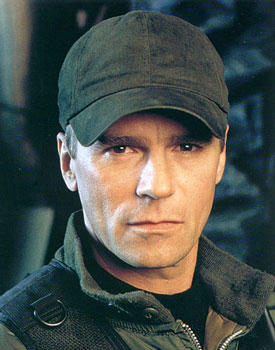
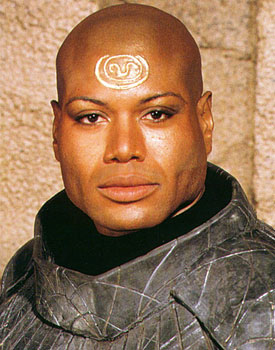
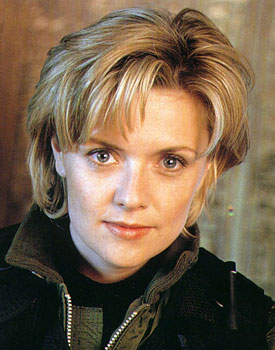
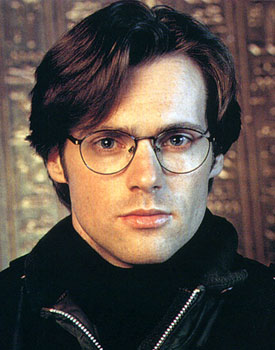
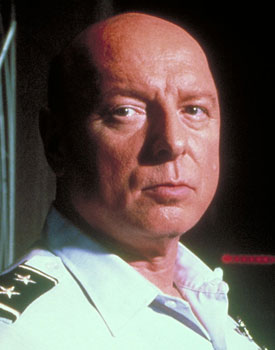
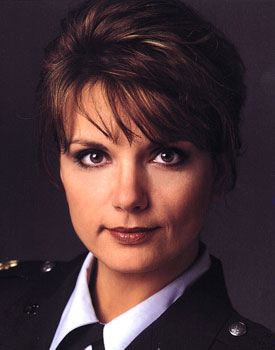
Teal'c, played by CHRISTOPHER JUDGE, is a Jaffa warrior who switched sides to join Colonel O'Neill in the fight for freedom against the evil Goa'uld.
THR: How quickly did you gel with your castmates?
Christopher Judge: Michael (Shanks), Amanda (Tapping) and I [bonded during our] screen test. No one believes this, but we three went off by ourselves, and for some reason, we found the whole thing funny. We were laughing and joking around, while everyone else was still preparing. We just had this natural chemistry, and we thought, God, wouldn't it be great if it were the three of us [cast since] we get along this well?
THR: As the resident alien on "SG-1," how has Teal'c grown along with the ensemble?
Judge: The one thing that the producers and I agreed on is that Teal'c's evolution should be slow. Knowing that you have 44 episodes going in, you can make believable character arcs.
AMANDA TAPPING portrays Major Samantha Carter. A mainstay on the "SG-1" team, Carter has a Ph.D. in astrophysics.
THR: What drew you to "SG-1" and the role of Carter?
Amanda Tapping: I wasn't a huge sci-fi fan, but [the show's] stories are told from a present-day, human perspective. And [Carter is] strong - it turns out she's probably the smartest member of the team. I hadn't read a lot of female characters that were like her.
THR: What was the first time you acted against a blue screen like?
Tapping: In one episode, "The Tokra," the visual-effects people told us what would happen and said we were [supposed to act] completely in awe. So I played it full tilt. They did this raking shot down the row of the four of us, and the guys weren't reacting at all. Then they get to me, and I'm like, "Ooh! Ahhh." That was my big note to self with blue screen: Make sure the other actors are reacting the same way, otherwise you'll look stupid.
MICHAEL SHANKS plays Dr. Daniel Jackson, a civilian anthropologist and explorer whose humanism guides him through each mission.
THR: Are you surprised by the show's staying power?
Michael Shanks: I'm very surprised it took off this way. I didn't think it would last more than a year or two at best, and here we are five years later.
THR: What intrigued you about the series?
Shanks: The variety is the most intriguing part about it. Each episode is completely different than the previous one. You have your consistent scenes - [which] establish the dynamic of team members and what life on Earth is like - but in terms of adventures, anything is possible. Each time we step through the gate, there's something new out there.
DON S. DAVIS' General Hammond is in charge of the "Stargate" facility.
THR: What does the 100th-episode mark mean to you?
Don S. Davis: That 100th episode is a milestone that we'd all like to achieve. Some shows, obviously, hit more than that. I thought that "Twin Peaks" was going to be one of the high points of my life, and it's a show people still remember - even though we only did 30 episodes. This one, we've done a 100! I think that's saying something.
THR: What is the underlying theme of "Stargate"?
Davis: It's a humanist viewpoint. You have two choices in life: make a difference or make a profit.
TERYL ROTHERY plays Dr. Fraiser, who runs the medical facility at the military base that houses Stargate Command.
THR: Although Fraiser's efforts are largely based at Stargate Command, does she ever have the chance to go exploring off-world?
Teryl Rothery: Fraiser has gone through the gate on a few occasions - and I love it. You have to pinch yourself when you think about what we do for a living. It's just so much fun; we get to play and use our imagination and pretend that we're in these places. It's like being a kid and getting paid for it.
____________________
Perenson, Melissa J., "Gate Mates." The Hollywood Reporter. September 4-10, 2001: p. S-3.
TRUE VALUE
The talented behind-the-scenes team puts it all up on the screen.
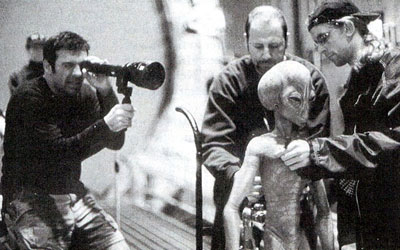
GOO MAN GROUP: Snappy dresser Thor gets an on-set lube job and body wax from Vancouver's finest in practical effects.
"Stargate SG-1," the series, is not unlike the fantastical Stargate itself: a gateway to new worlds, week in, week out. "The most unique aspect about working on 'Stargate' is producing a show that's within the sci-fi genre that allows you to push the envelope and create whole new worlds each week," says Michael Greenburg, an executive producer of "SG-1."
With producing partners Richard Dean Anderson, Brad Wright and Robert C. Cooper, Greenburg oversees 22 episodes per season, each budgeted between $1.5 million and $2 million. A cluster of Vancouver-based vendors supply all the required production elements for the series - from sets and costumes to sound and visual effects, color correction, lab processing and transportation. Since the inception of "Stargate SG-1" five years ago, the crew, which includes some 300 regulars, has hit its stride: "SG-1" has received a number of industry kudos. (See sidebar.)
Five soundstages house the series, and at any point up to six weeks prior to an episode's shoot date, a stage might be buzzing, literally, with the sounds of set construction. "We have two soundstages at the Bridge Studio - our main sets are there - and then we have another studio, Norco, with three soundstages about five miles away. Our construction model shop, paint shop and welding shop are across the street from Norco along with all of our set decoration and storage," Greenburg says.
Although the series' creative demands may fire the imagination beyond what a weekly budget allows, Brad Wright, executive producer, knows how to reel things in. "At first we bit off a little more than we could chew; we would try to tell a story that was bigger than a television budget can effectively tell. But (now) I think we've been able to put more on the screen," he says.
The show's two cinematographers, Peter Woeste and Jim Menard (who shoot alternating episodes), get involved during preproduction to help determine which shots are doable as in-camera effects and which will require visual effects in post. Considering that "Stargate SG-1" averages between six to 100 visual-effects shots per show, planning ahead is key to the well-oiled "SG-1" machine.
"The process can be quite slow," says Peter DeLuise, creative consultant, who directed the 100th episode, "Wormhole Extreme," and 23 other episodes since he joined the show during its second season. "But that's why we get a jump so far in advance," he says, "so our art department has the chance to try and fabricate some of the incredible things that end up in the scripts." Not only are there lush surroundings to fabricate for new planets, but there are often complex designs to create for the spaceships and space stations. Then there's the gate itself, an impressive ringlike structure that stands 20 feet and is made of steel, covered by a fiberglass casting and weighs in at 2,500 pounds.
Unlike the gate in the feature film, the series' gate features 39 different symbols around the ring. Plus, the "Stargate" model is mechanized, so it simulates the action of "dialing" a new planetary location. "We can't move the gate because it's such a tricky piece of engineering. It's over 20-feet wide, and it has a gearing system hooked into a computer. It's worked perfectly and has never failed," says Richard Hudolin, the show's production designer.
Hudolin often taps into the annals of ancient history to come up with designs that match the writers' renditions of the stages of human evolution. "We can pick from historical or geographical locations or religious references. Just about anything that you can think of is a source for us. A tire track actually turned into one of the main designs for 'Replicators.'"
"Oftentimes, we'll matte the Stargate in with the background, so we can put ourselves anywhere we want," Wright says. "Pyramids, moons - whatever your imagination can dream up - we can put our cast right in the middle of it."
From the outset, "Stargate SG-1" made a splash with its visual effects. Its two-hour movie premiere, "Children of the Gods," was nominated for a Best Visual- Effects Emmy in 1998. "The level of visual effects and the level of production is equal to or exceeds anything else you'll see on series television," raves Hudson Hickman, senior vp of production for MGM Television.
The show has since been nominated for three additional visual-effects Emmys - including two nominations this year. James Tichenor, visual-effects supervisor, oversees an in-house graphics team of 10 people. "If effects were done as traditionally as they had been five or six years ago - for television at least - I don't know if they would have tried to mount the series. But as the series has progressed, we've done more and more effects," Tichenor notes.
It's no coincidence that the series alternates between heavy visual-effects episodes and those with lighter demands. "If we throw a $400,000 visual-effects budget at the visual-effects department for one episode, that episode takes these guys two or three months to complete," Wright notes. "That's why we subcontract out a lot of the shots and do a lot of in-house work with matte paintings and rig removal."
Among the regular shops "Stargate SG-1" hires are Rainmaker Digital, Image Engine, Lost Boys, GVEffects and Northwest Imaging.
Amidst the series' array of complex visual effects, the billowing effect that marks the Stargate's activation - dubbed the "Kawoosh" - remains one of the show's most eye-catching, second only to the "puddle" effect of the shimmering surface that the "SG-1" team walks through to transport themselves across the galaxy. These shots are the only stock shots the series uses from episode to episode, and the same five shots have been used since season one.
'SG-1' Milestones
1997
Series debuts on Showtime.
CableACE Award: Best Dramatic Series
1998
Emmy Nominee: Music Composition, Joel Goldsmith; Visual Effects, "Children of the Gods."
MPSE Golden Reel Nominee: Best Sound Editing.
MGM strikes syndication deal with USA Network's Sci-Fi Channel.
1999
Saturn Award: Best Actor in a Syndicated Series, Richard Dean Anderson.
2000
Saturn Award: Best Syndicated Series.
Leo Award: Best Overall Sound.
Leo Nominee: Best Cinematography, Jim Menard; Best Female Performance, Amanda Tapping; Best Male Performance, Michael Shanks; Best Production Design, Richard Hudolin; Best Screenwriting, Victoria James and Brad Wright.
2001
Emmy Nominee: Visual Effects, "Small Victories"; Visual Effects, "Exodus"
____________________
Perenson, Melissa J., "True Value." The Hollywood Reporter. September 4-10, 2001: p. S-4+.
SCI-VIBE
Overachiever Joel Goldsmith provides the 'SG-1' underscore.
Composer Joel Goldsmith was enlisted for a tour of duty with "Stargate SG-1" by executive producers Jonathan Glassner and Brad Wright, with whom he'd worked on the Showtime series "The Outer Limits."
The composer jump-started the pilot in 1997 and has been underscoring the series ever since. "Generally, I try to approach it emotionally. I look for subtexts that I can exploit musically," Goldsmith says. "Over the years, we've developed a lot of themes for different characters and tried to give all of these different alien creatures their own identity." Goldsmith found the right pitch early in the series, receiving a 1998 Emmy nomination for his work on the season one episode "The Nox."
In spite of the show's frequent doses of sly humor, Goldsmith prefers to keep the pace stately - especially in deference to the series' military overtones. "I tend to keep a stoic, noble feeling about the military. And often I'll ignore the humor. I just let [the jokes] play and stay quiet," he says. "It's easy to get cartoony if you play the humor."
Instead, Goldsmith has adopted the sweeping sound that was established in the feature film. "We've always wanted to have a symphonic sound, even though we do much of it electronically," he says. "The original tone (for the 'Stargate' score) was set by David Arnold. And we've stayed true to his initial tone for 'Stargate SG-1': It's a big score, and the music is important. It works very well with the show." The main-title theme for the show is Arnold's from the film; Goldsmith contributed the end-credit theme.
Goldsmith typically has a week to score an episode. After he reviews the producer's cut, he receives the final cut. From his L.A. studio, he teleconferences with producers Brad Wright and Robert Cooper in Vancouver and they "go through the show scene-by-scene. Robert or Brad will talk about it and tell me where they feel the music should begin and where it should end."
Although Goldsmith relishes the freedom he has to experiment with the score, he acknowledges that the final result represents the close collaboration between himself and the producers. "The producers are really into the music," he says. "They're clear on what they want and are able to communicate that while still giving me creative freedom and encouragement to go off in my own direction. That part is a big bonus. Composers don't get flexibility like that very often."
____________________
Perenson, Melissa J., "Sci-Vibe." The Hollywood Reporter. September 4-10, 2001: p. S-4.
FLAIR FORCE
Real-life bluesuiters advise the 'Stargate SG-1' team.
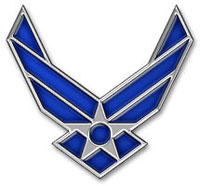
What do Amanda Tapping and silent film star Clara Bow have in common? The sound military advice of the AFELO. Established in 1927, the U.S. Air Force Entertainment Liaison Office (AFELO) first imparted its authentic military touches on the Oscar-winning, Bow-starring, William Wellman movie "Wings." Eight decades later, the production team on "Stargate SG-1" requested the AFELO's guidance for its own futuristic Air Force team. "Every week when we open a new script, it's amazing to see what these Air Force people are doing," marvels Tom Giannazzo, U.S. Air Force master sergeant, who handles the "SG-1" crew on behalf of the AFELO.
The Air Force not only consults the writers about military protocol, it also reviews scripts and rough cuts of the episodes, looking for issues, contradictions and ways to make the series more rooted in military reality. "The scripts come in via E-mail," Giannazzo says. "We'll go over them; then we'll give [the writers] notes for things that are problems, such as relationships and language, to help make sure [the representation] is accurate."
Giannazzo also keeps an eye out for such minutiae as character hairstyles that have strayed outside regulation parameters. The AFELO has even facilitated production by contributing shots of Stargate Command headquarters, which are shown in the series each week (the shots are of the actual exterior of the Air Force's Cheyenne Mountain facility). "We got them a C-130 airplane for the episode 'Watergate,' where they supposedly parachuted into Siberia," Giannazzo says.
The level of cooperation between the "Stargate SG-1" production and the Air Force benefits the AFELO, too. "We've [put] the fictional characters to good use," Giannazzo says. "The cast all recorded public-service announcements that are used by the Air Force Recruiting Service."
The series - a hit with Air Force personnel - is shown on Armed Forces Radio Television Service in hundreds of countries overseas. Visit (www.airforcehollywood.af.mil) for information.
____________________
Perenson, Melissa J., "Flair Force." The Hollywood Reporter. September 4-10, 2001: p. S-11.
MESSAGES OF THANKS AND CONGRATULATIONS
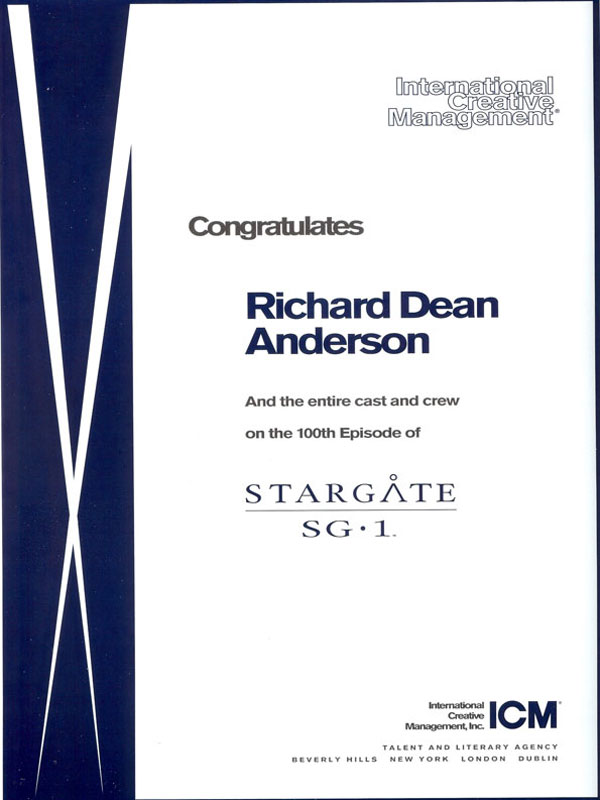
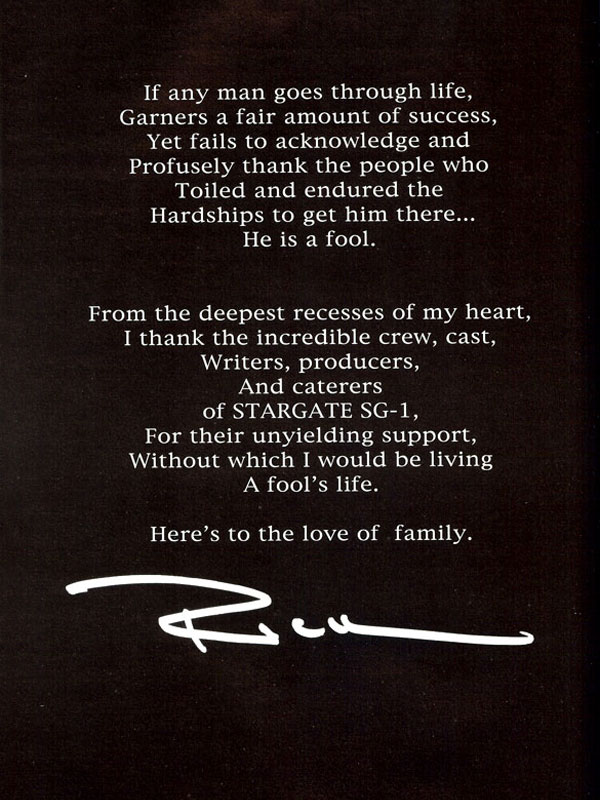
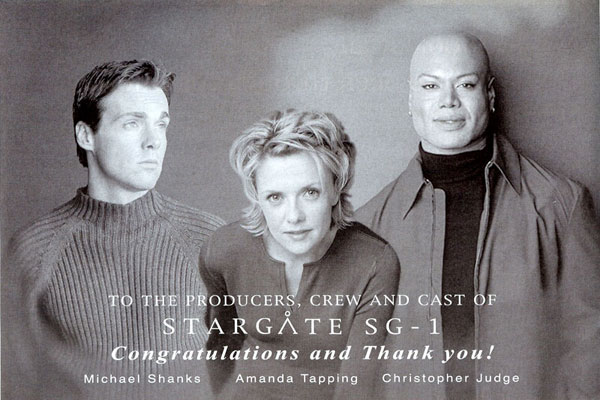
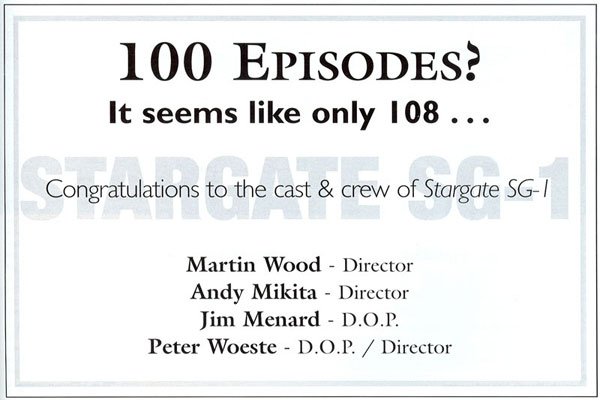
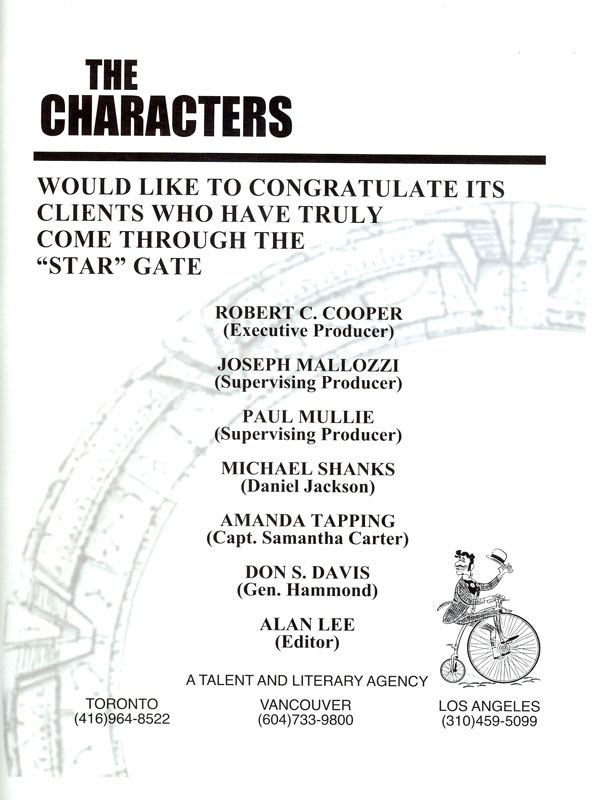
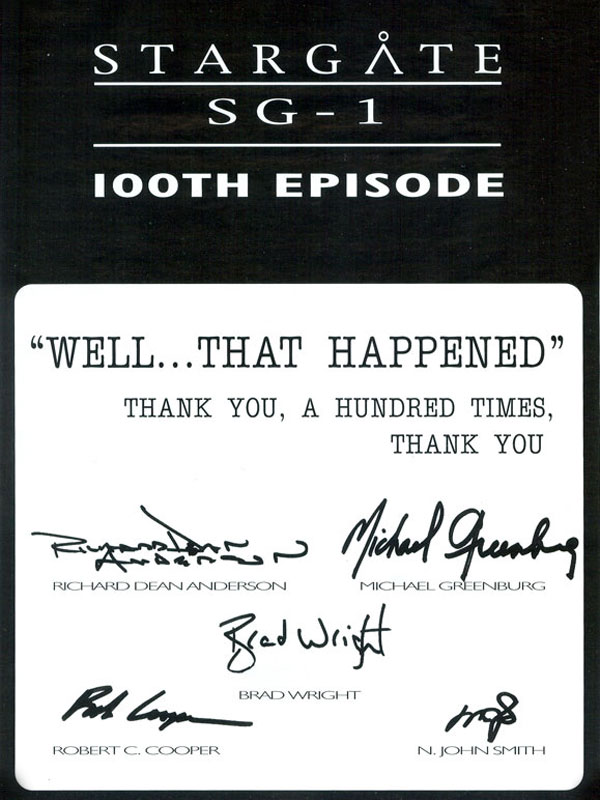
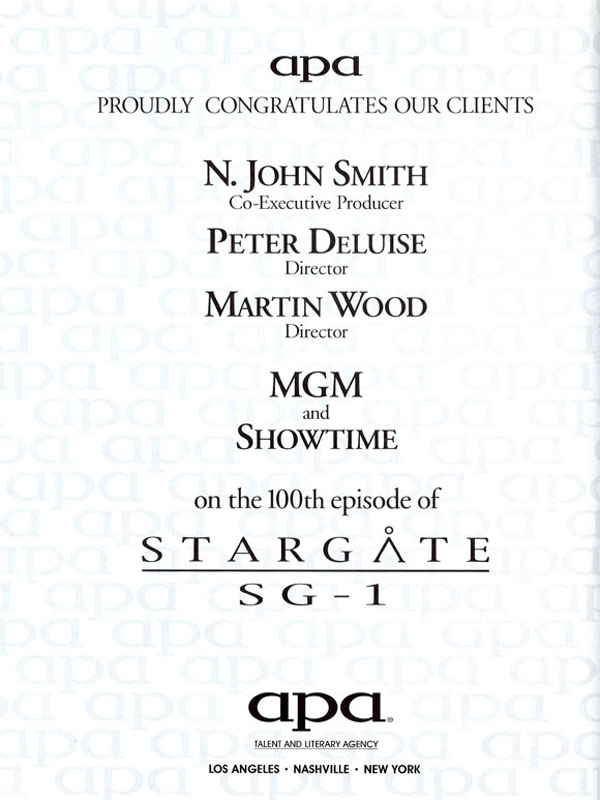
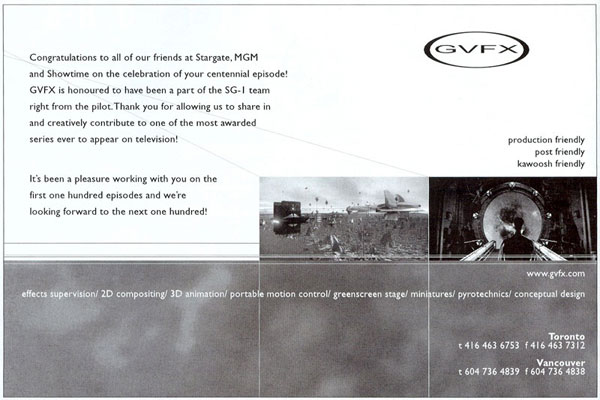
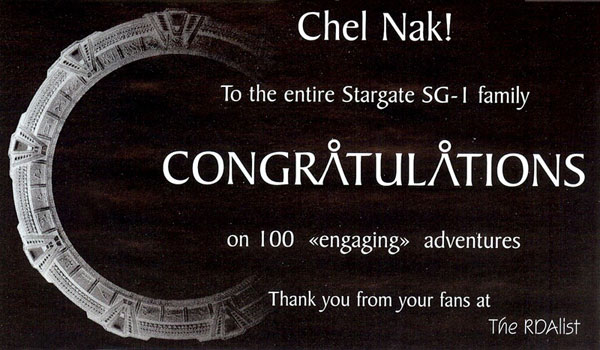
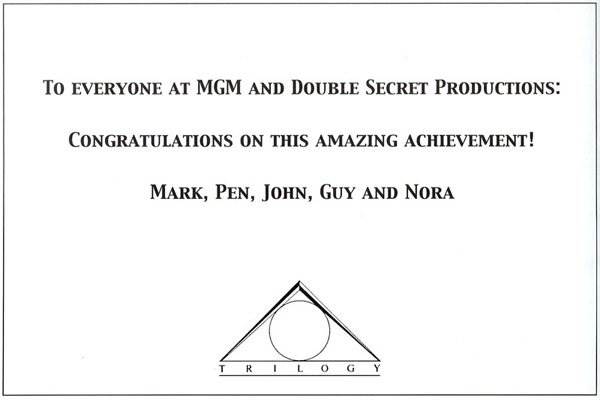
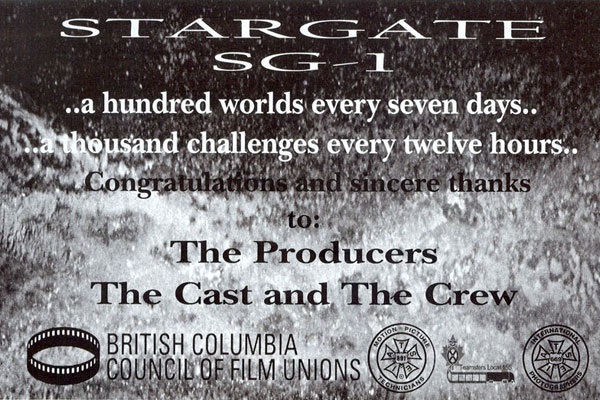
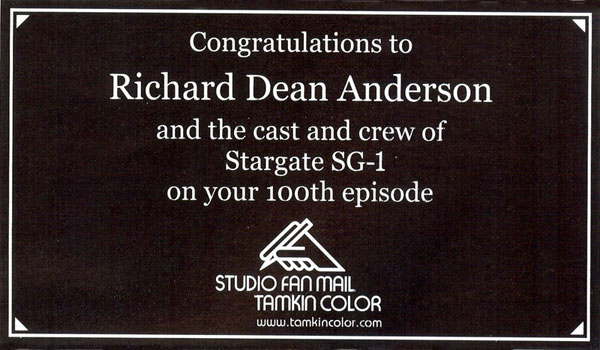
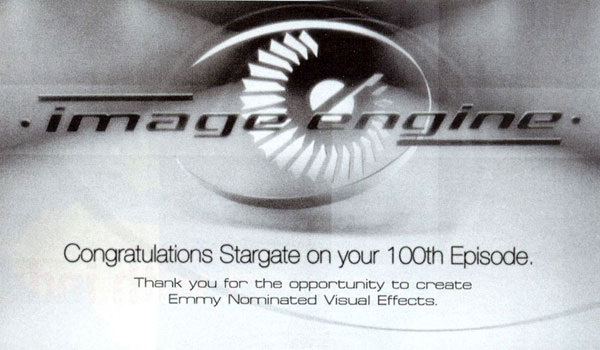
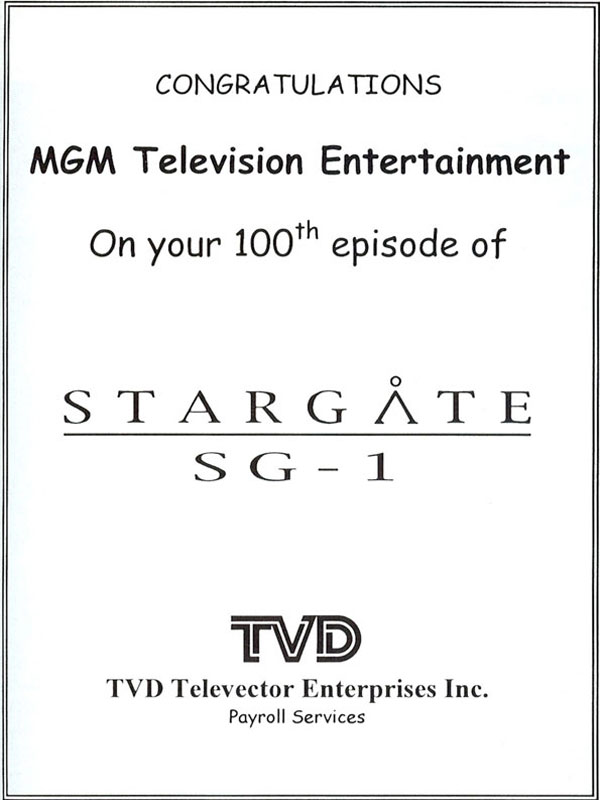
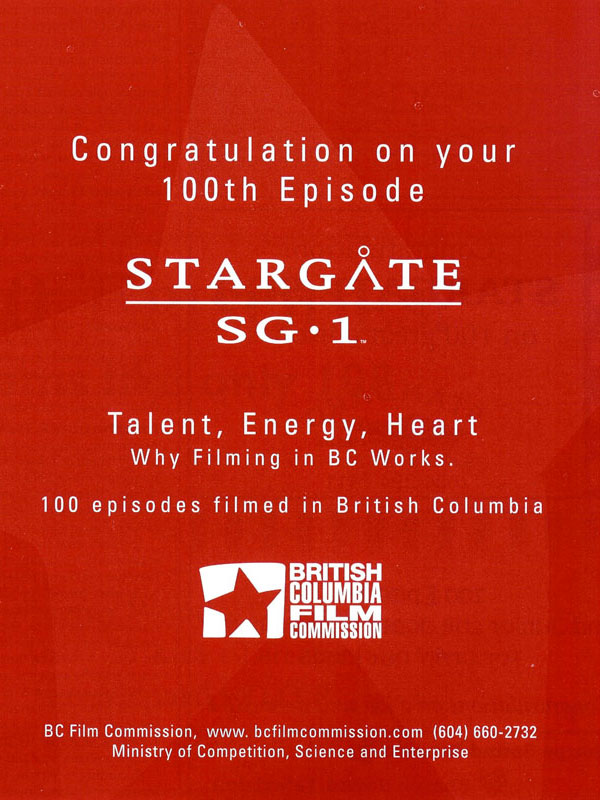
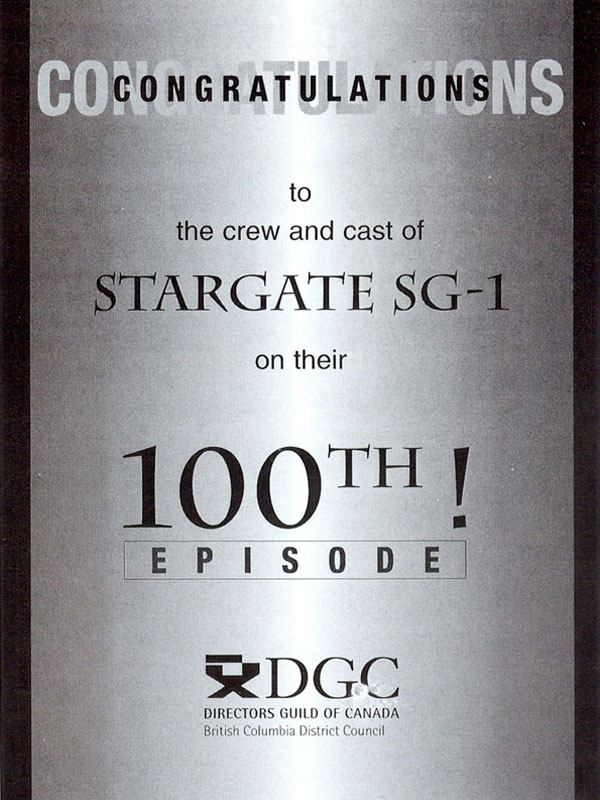
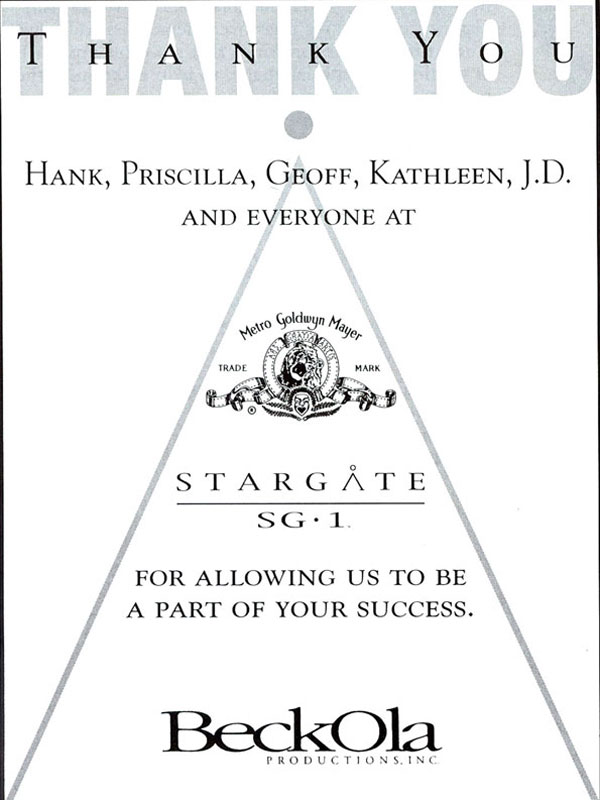
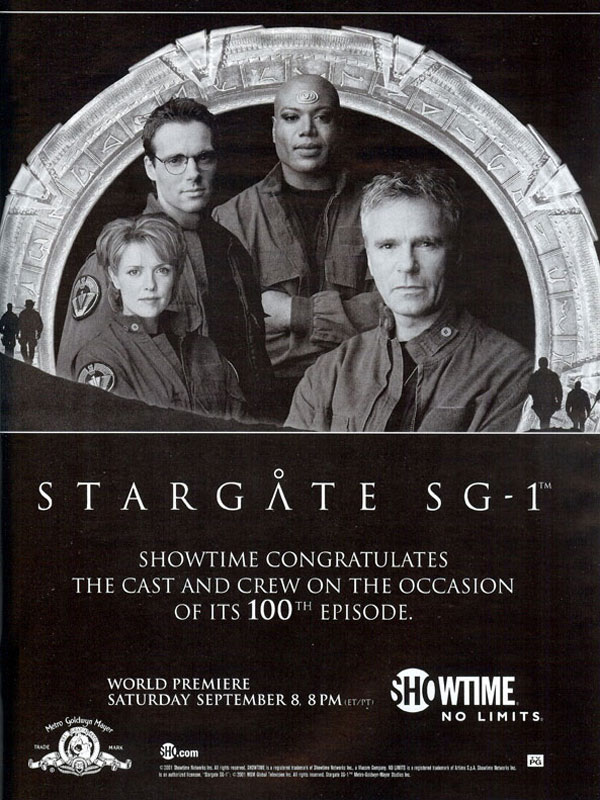
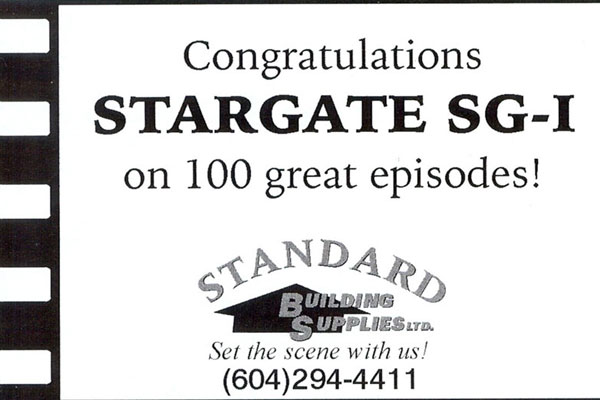
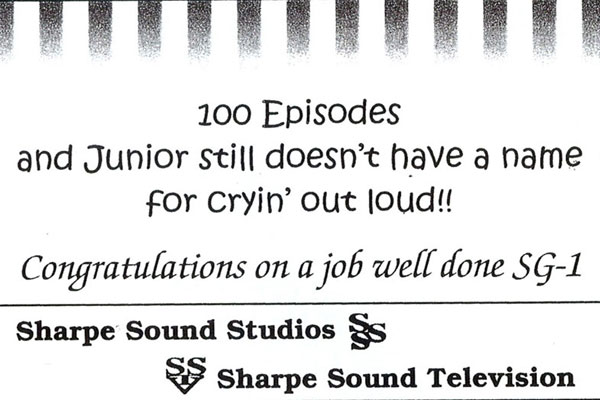
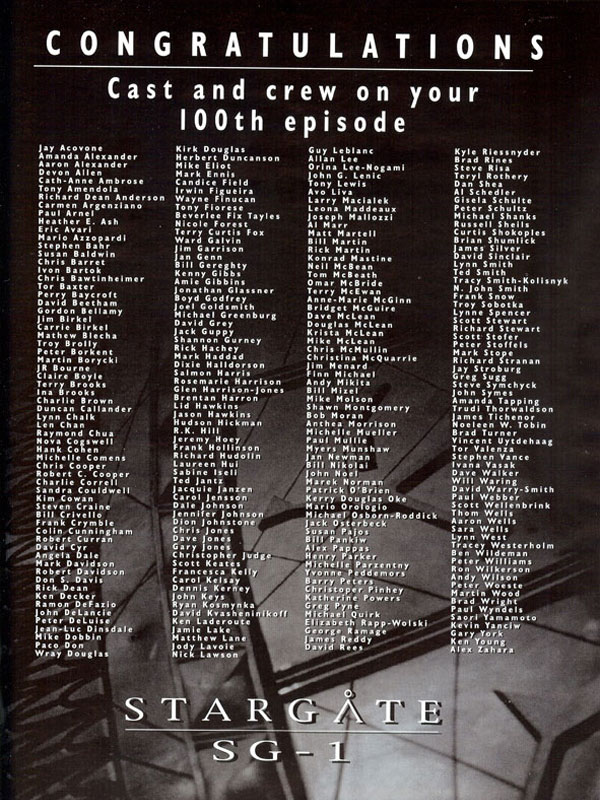
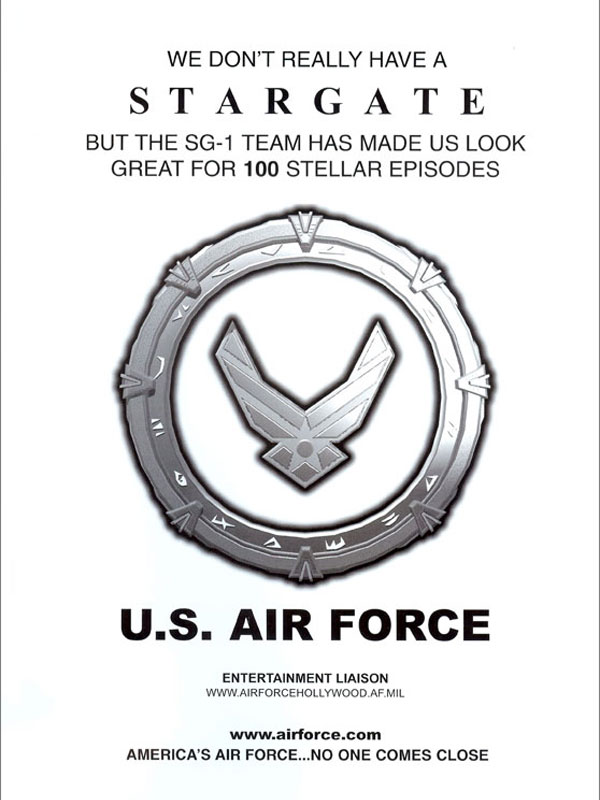
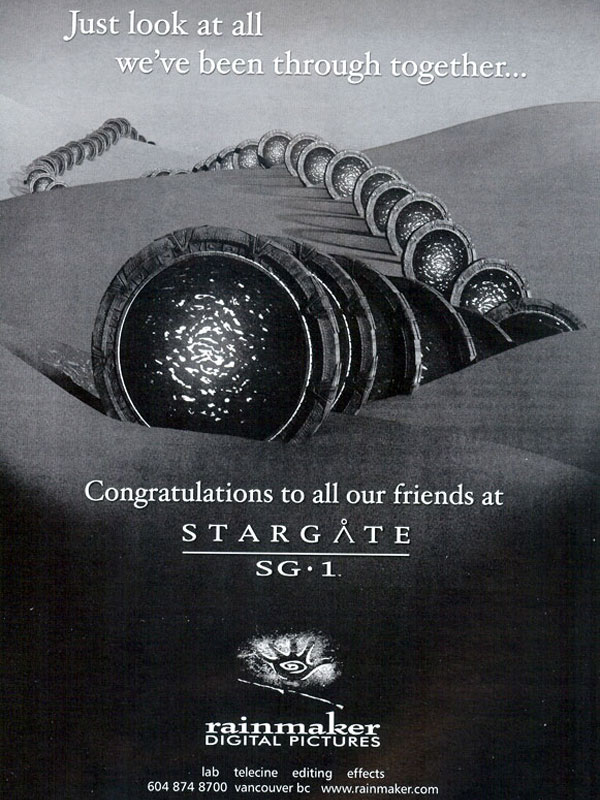
____________________
Dowling, Robert J., editor-in-chief. "Stargate SG-1 100th Episode." The Hollywood Reporter. September 4-10, 2001: p. S-1 to S-15.
